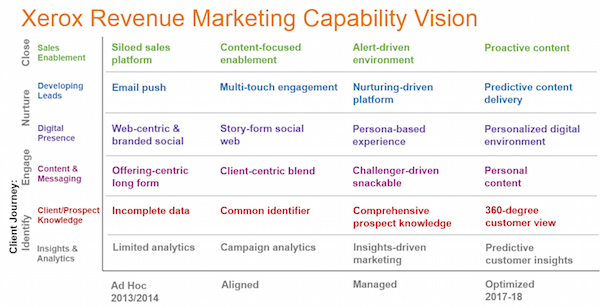The following is a guest Q&A conducted by Claire Schoen of Third Door Media, the producers of the MarTech conference series. Claire interviews Laura Patterson, president & co-founder of VisionEdge Marketing, who will be one of our featured speakers at MarTech next month.
As President of VisionEdge Marketing (VEM), Laura Patterson is a champion of performance-driven marketing. An early pioneer in the science side of marketing, she is the author of the book “Marketing Metrics in Action.” Before VEM, Laura spent 20 years in industry, including fourteen years at Motorola, where she began in sales and ultimately became Director of Customer Marketing and Brand Strategy.
We recently spoke with Laura about her thoughts on how marketers can earn better grades from the C-suite, and why it’s so important to thoroughly understand the marketing process before adopting and using technology.
Keep reading for an up close and personal interview with Laura. Then secure your place to meet her at MarTech. Register today!
Tell me about your background — how did you end up where you are now?
I entered the world of marketing in the late 70s, well before marketers had anything like the technology we employ today. (Remember the blank computer screens with blinking green lights?!) For nearly 20 years, I worked on the corporate side of marketing – financial services, healthcare, enterprise and application software and hardware. There have been a lot of changes!
While at Motorola, my customers included tech companies like Apple, Cisco, Logitech — companies that were building out the technologies we’re using today.
In 1999, I made the switch to consulting. As a data-driven, tech person, I wanted to combine my marketing strategy and customer experience work with my marketing science and operations background. We formed VisionEdge Marketing to help marketers use data and science to measure and improve their marketing. That was 17 years ago.
Right from the start, we focused on helping our customers make their marketing customer-centric, measurable, and actionable — words that no one was using at the time. This is still our focus.
You’ve done some recent research about marketer personas. Can you share what you learned?
For 15 years, we’ve been conducting the marketing performance management study. As a result of the data, we’ve identified three personas: Value Creators, Sales Enablers, and Campaign Producers. The Campaign Producers are the most “traditional” marketers, those who create content, build campaigns and websites, and manage events, etc. The Sales Enablers see themselves “in service” to the sales team, and their job is all about generating leads with their primary focus on the pipeline.
The Value Creators, however, are more focused on how to align marketing to the overall business strategy, to create and extract value, and to move the business needle. They’re the ones earning the “A”s from the C-suite.
What are these “A” marketers doing differently? They’re spending the time to develop business acumen and learn the language of the business. They’re not just focused on output statistics like downloads, pageviews, open rates, fans/followers, leads, etc. Their marketing operations expand beyond automation to serve in a more strategic role designed to transform Marketing into a Center of Excellence. While all marketers today are digging deep into the realm of data, the A marketers know exactly what data they need and why, because they are focused on the bigger picture. They make their data more relevant to the business and use the data to help them align their efforts to business outcomes. Not sales outcomes, business outcomes.
Theirs is a longer term, overall market view, looking at issues such as how to build customer loyalty, improve customer experience, and when and where to expand products. These are the marketers that are getting the attention of the C-suite.
When marketers can successfully combine business acumen with customer insights and relevant data, they become more credible to the C-suite — and thus more influential within the organization.
What will you cover in your presentation at the MarTech conference?
The presentation is titled “With Credibility Comes Influence and Relevance: How You Can Employ Performance Management to Achieve All Three.”
In this session I’ll share more insights about how marketers can learn from these “Value Creators” to gain better marks and drive marketing success within the organization. Specifically, I’ll share six areas where best-in-class marketers are excelling, as well as how marketers can use performance-based marketing to improve the value of marketing.
What are your thoughts on where we are now with marketing technology?
So many marketers are focused on the tools when they really need to understand the systems and processes first. My dad was a handyman, and he had a great expression: “If you don’t have the skill to use a tool, then using a power tool will only enable you to do more damage, faster.”
There are two things here, really. First, before you even pick up a tool, you need to understand the process and the system for using it within your business. For example, you need to understand why you’re sending an email before you concern yourself with building out a branded template. What are you trying to accomplish and how will you measure your success?
Second, you need to know which data is relevant before you pull it. So many marketers are getting bad marks from the C-suite because they’ve purchased all kinds of marketing tools and are presenting all sorts of data, but too much of it is not relevant. The C-suite is saying “you’re giving us all these numbers, but we don’t get the sense that you’re moving the business needle.”
We’re at a point where marketers now have the power tools, but they don’t have all the skills to use them effectively.
What advice would you give to someone just starting out in marketing?
Be willing to work hard. Don’t be afraid to ask questions, and be willing to say “I don’t know” when you don’t. I also think it’s important to understand the process, to be able to map out workflow and really understand the “why” of what you are doing. You need to know the process before you learn the tool.
And — this may sound obvious — don’t be afraid to pick up the phone to solve a problem. I recently had an issue with one of our martech platforms and it took 10 days of back-and-forth email before someone finally called me. We solved the problem in 5 minutes once we were on the phone. That’s 10 days use of that platform gone.
Tell me something we might not learn from your LinkedIn profile.
I used to run triathlons but I’ve given that up and now do yoga, which I find to be both a great workout and a great way to reduce stress.
And I love hardware stores. (I’m enamored with power tools.)
Thank you Claire and Laura!




Claire and Laura — great piece. Love the use of Personas and the ones you defined are spot on. Many questions come to mind, but I’ll choose this one….How do you see these different personas playing together within an organization (from a team and a management hierarchy perspective), especially in this current evolution of Marketing that is leveraging more technology and data?